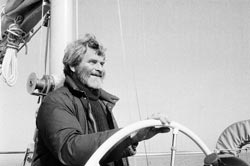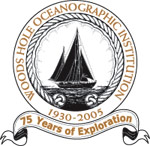This is an archived site. This site is no longer being maintained or reviewed for broken links.
Employee Portrait Gallery—Frank Carey
 |
|
|
Looking like the quintessential old salt, Frank Carey takes a small boat out for work on big fish. An interviewer once wrote that he came away from conversations with Carey “impressed by his sly sense of humor, his salty manner, and his astonishment with the world.” (Photo by L. Hoyt Watson) |
|
Garbed in foul weather gear and working on a spray-soaked fishing boat, Frank Carey became an expert on big fish while enjoying every minute of their vigorous pursuit. He came to WHOI as a postdoctoral fellow in 1961, following an undergraduate degree from the College of William and Mary, graduate work at Yale, completion of a Ph.D. in biology at Harvard, and a postdoc at Duke. He first worked with John Kanwisher on animal physiology, but soon turned his attention increasingly to marine mammals and large pelagic fish. A colleague described him as “undoubtedly the world’s authority” on the physiology, behavior, and ecology of the great migrating fishes of the sea—among them tuna, sharks, and swordfish. He also made the first body temperature measurements of a great white shark when his research party encountered one by chance off Montauk Point, Long Island, in 1979.
Working with ecologist John Teal, Frank investigated the warm-bloodedness of some large pelagic fish that are able to control, for example, the temperatures of their brains and eyes—critical systems for wide-ranging predators. (Most fish are cold-blooded, that is, the temperature of their bodies adapts to that of the surrounding water.) With WHOI colleagues, Frank developed tags and tagging techniques for tracking tuna and sharks that foreshadowed tags used today. He continued working and thinking about his research until his death in 1994. His fascination with these animals and an infectious spirit of curiosity inspired students and other scientists. The work he began continues in their research on migration, behavior, and physiology of pelagic fish. In 1994, California colleagues based at Stanford’s Hopkins Marine Station and the Monterey Bay Aquarium dedicated their new, jointly sponsored tuna research center to him.
When not at sea, Frank lived in a big, old farmhouse surrounded by fruit trees, gardens, and various pets and poultry. He would invite new WHOI scientists from other places to dinner, and teach them how to prepare local bluefish the right way: baked, topped with onions, tomatoes, and fresh basil from his garden.
[back]

